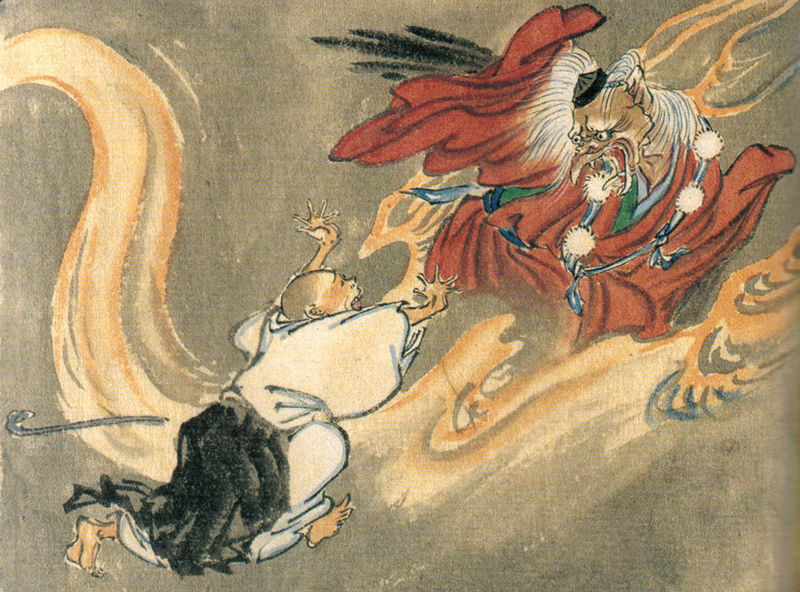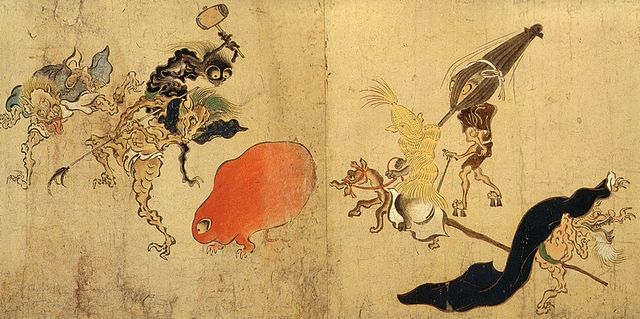Sep 29, 2022
Yōkai, the Weird World of Japanese Spooks and Spectres
Halloween is all about spooky stuff, right? There are various bone-chilling tales coming out of medieval Europe for its origins – the dead returning, devils punishing Irishmen, ghosts, spooks, and witches.
But the west isn’t the only place with these traditions. Japan too has plenty of things that go bump in the night. ‘Yōkai’, a motley crew of phantoms, specters and supernatural beings, are spoken of in folklore from all over the country. The word yōkai is made up of the kanji for “bewitching; attractive; calamity;” and “spectre; apparition; mystery; suspicious”, and their origin can be found in the animism and nature worship of Shintoism, and the concept that gods, or kami, can be found all around us.
As yōkai reside on the very border of our realm and the “other world” they are most likely to be found at twilight, a time when the boundaries between our world and the astral planes are most blurred. Some are malevolent, some are naughty, some bring good luck, and some are just downright weird. Here are a few that you wouldn’t like to bump into in a dark alley at night.
Tengu
As Japan is 80 per cent mountainous, it’s going to be pretty hard to avoid the terrifying Tengu that reside within their depths. While their name means ‘heavenly dog’, they can take on numerous shapes, though they are commonly birdlike, have wings which allow them to fly, talons, and a red face with a long nose or beak.

As Tengu prefer to kidnap the defenseless, they are particularly dangerous for children and the elderly, but even the bravest of mountain travelers can be brought to a quivering wreck at the sounds of their whispers, drumming and laughter that echo through valley passes, while their weather-changing abilities can whip up winds out of nowhere and cause stones and boulders to rain down from above. I think sticking to sea level might be a good idea. Although, with that said…
Ushi-oni
…One of the worst things that can happen when swimming in the late summer sea in Japan is coming face to face with a jellyfish. The absolute worst is coming face to face with Ushi-oni. Literally ‘cow demon’, the ushi-oni can take many forms depending on where in the country you are, but off the coast of Shimane Prefecture and other places in Western Japan it is a terrifying sea-creature with a spider- or crab-like body and the head of a cow that attacks fishermen.
It is sometimes accompanied by ‘nure-onna’, a demon who appears before an ushi-oni attack and tricks the fisherman into holding her child, which then becomes stuck to the person’s hands and grows heavier in order to hinder escape. Worse than sunburn, being stung by a jellyfish, and getting sand in your kakigori combined.
Gashadokuro
If you thought that living in the Japanese countryside seemed an idyllic way of life, think again. Gashadokuro, immense skeletal beings who wander rural areas in the darkest hours of the night, are formed from the bodies of slain warriors or victims of famine who, having not been afforded proper funerary rites, rise up to wreak their revenge on a cruel world.
As skeletons are wont to do, their bones rattle with a “gachi gachi” sound, from where it gets its name. If they should happen upon a human out late on the roads, the gashadokuro will silently creep up and catch their victims, crushing them in their hands or biting off their head. I won’t be leaving my apartment in central Nagoya any time soon.
Nekomata
Not that you are safe from yōkai in the cities, though. One creature that can be found as often in urban settings as rural is the bakeneko (changed cat), funky felines that can walk on their hind legs and talk in human languages, many of which are friendly and helpful. However, one such bakeneko, the nekomata (forked cat), is downright nasty.

Recognisable due to its twin tails, deep in the mountains nekomata can grow to many meters long and prey on boars, bears and any humans that cross their path, but they also wreak havoc in the towns and cities. Contemptuous of human life, nekomata can conjure up fireballs that initiate great blazes, killing many people, while with their necromantic powers they control corpses as puppets through ritualistic dance, blackmailing and enslaving humans. Sounds a lot like a cat I once had, come to think of it.
Kappa
When I was a kid my gran once told me to keep away from the edge of the river near her house “unless you want your backside slapped”. There are other reasons to be fearful of the water’s edge in Japan.
Kappa are extremely popular in Japanese culture and are often depicted as being quite cute, but these amphibious creatures, with webbed fingers, red eyes and skin reeking of rotten fish, are known to pull people into the water where they drown them and drink their blood, eat their liver or remove their ‘shirodama’, the soul-containing mythical bowl that found within the anus. As stinging as my gran’s spanks were, they weren’t as bad as all that.
Betobeto-san
Have you ever had the feeling you’re being followed but there’s no one around? It’s a good chance that you have come across Betobeto-san. Betobeto-san, or Mr Clacking Sandal (sounds spookier in Japanese, doesn’t it) is a specter of no discernible form, only recognizable by the sound of its wooden ‘geta’ sandles clacking on the road, beto beto beto beto…
Betobeto-san is a benign spirit, though he is particularly unnerving for the unaccompanied travelers he follows down darkened, deserted pathways, synchronizing his footsteps with the walker, growing ever-closer with each step, following them wherever they go. Should you find Betobeto-san on your tail, simply step aside and say “after you Betobeto-san,” and he will pass by. Obviously he is a yōkai who believes in good manners.
Shiri-me
Shiri-me, like Betobeto-san is another yōkai that is more mischevious than it is malign, but if weirdness was up there with danger, the Shiri-me would give Gashadokuro a run for its money. For all intents and purposes, Shiri-me looks like a regular kimono-clad guy. You may not think anything of it as he calls out to you, asking if you have a moment to spare. If it is a dark evening, you probably wouldn’t even notice that his face is entirely featureless. However, you are likely to be a bit surprised as he hurriedly removes his clothes, bends over and pulls his buttocks apart to reveal a giant eye instead of an anus. As his name is literally Butt-eye, it probably shouldn’t come as a surprise. But I bet it would. Actually he’s not a bad guy, just a bit of a prankster getting off on shocking and sickening people. A bit like Jackass. But without the Jack.
Image [Public Domain], via Wikipedia (modified)
Image by via http://s3-ap-northeast-1.amazonaws.com/kakista/pictures/3734/original/ushioni.jpg?1318401411
Image by Utagawa Kuniyoshi, (Own work) [Public Domain], via Wikipedia (modified)
Image [Public Domain], via Wikipedia (modified)
Image [Public Domain], via Wikipedia (modified)
Image [Public Domain], via Wikipedia (modified)
Image via https://vignette.wikia.nocookie.net/yokai/images/9/99/Betobeto-san.png/revision/latest?cb=20150205213707 (modified)
Image via https://hyakumonogatari.files.wordpress.com/2012/08/shirime.png (modified)







About the author